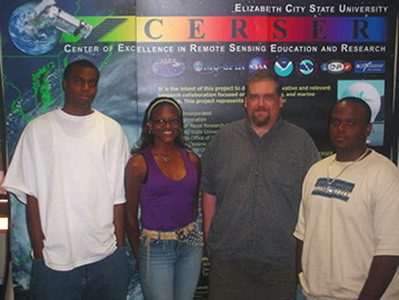|
Bottlenose
Dolphin Occurrence off the Virginia Coastline and its relationship
to Sea Surface Temperature |
| |
|
| |

(From
Left to Right) |
| Andrew
Thompson, Kimberly Mason, Mr.
Kevin Foss (Mentor), Javon Griffin |
| |
|
|
| Project
Purpose: |
| |
|
Due
to the unpredictable nature of their movements, bottlenose dolphins
are very susceptible to physical injuries and disturbance of behavioral
patterns. Several research organizations, such as the Office of
Naval Research (ONR) in compliance with the Marine Mammal
Protection Act(MMPA) have allotted funds towards finding a reliable
method of locating dolphins using remote sensing. To help minimize
these threats, we studied the possibility of locating the presence
of bottlenose dolphins using Advance Very High Resolution Radiometer
(AVHRR) using sea surface temperature and chlorophyll data obtained
from the National Oceanic Atmospheric Administration-National Ocean
Service Center for Operational Oceanographic Products and Services
(NOAA-NOS CO-OPS) and the Coastal Ocean Observation Lab (COOL) at
Rutgers University respectively.
|
| Project
Goal: |
| |
|
To
analyze and compare the field data to SST and chlorophyll data,
to determine if there is a correlation.
|
| |
| Methods
in Brief: |
| |
| Sea
Surface Temperature (SST) from AVHRR data served as the primary
source, however, records from the National Oceanic Atmospheric Administration
data station at Sewell's Point was used where temperature
from AVHRR was not available. Chlorophyll level data was obtained
from AVHRR graphics. Field data was collected from May 2000
to October 2001 using the passive observation technique from small
boat cruises on set transects. The 75 transects that were
made, there were 39 encounters. The voyages took place on
the Elizabeth River in Norfolk, Virginia.
The
field data, SST and chlorophyll data were entered into MS Excel
for analysis. The dolphin presence/absence data was normalized
to reduced bias from uneven effort. Comparisons were made
between SST and presence/absence, between SST and groups size,
and between chlorophyll and presence/absence for the study period.
|
|

